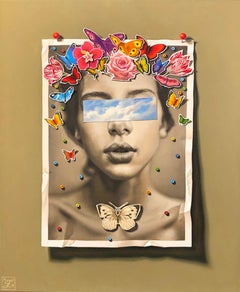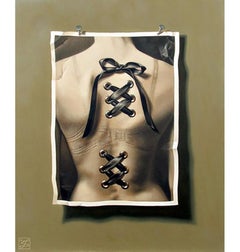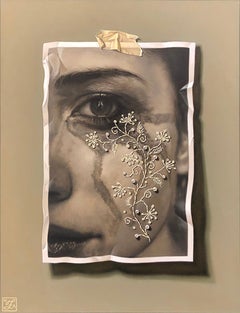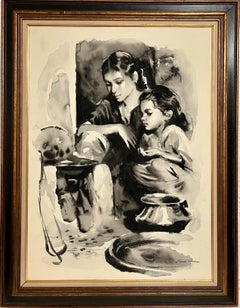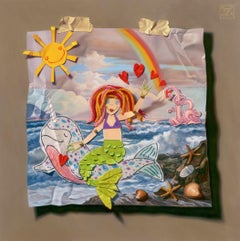Natalie Featherston Paintings
3
2
2
Overall Height
to
Overall Width
to
2
2
1
1
1
1
1
1
1
1
3
3
860
656
651
610
Artist: Natalie Featherston
Mariposa
By Natalie Featherston
Located in Lincoln, MA
oil on panel
Category
2010s Natalie Featherston Paintings
Bound
By Natalie Featherston
Located in Lincoln, MA
oil on panel
Category
2010s Natalie Featherston Paintings
Lacrimosa
By Natalie Featherston
Located in Lincoln, MA
oil on panel
Category
2010s Natalie Featherston Paintings
Related Items
Large Gouache Original Painting Mother & Daughter Sandu Liberman Israeli Judaica
By Sandu Liberman
Located in Surfside, FL
framed 36 X 28 board 30 X 21.75
Sandu Liberman (Romanian-Israeli) was born in Yasi, Romania in 1923. between 1946 and 1953 he took part in the state art shows in Bucharest. in 1952 ...
Category
20th Century Modern Natalie Featherston Paintings
Materials
Gouache, Paper
Profile Portrait Of Young Venezuelan Inmmigrant in Europe. Blue "Currency #193"
By Natasha Lelenco
Located in FISTERRA, ES
This piece is one of the most recent in the "Exchange Currency Series" created by Natasha Lelenco in 2024, inspired by the concept of the "face" on coins. It is a unique work consist...
Category
2010s Pop Art Natalie Featherston Paintings
Materials
Wood, Spray Paint, Acrylic
Natasha LelencoProfile Portrait Of Young Venezuelan Inmmigrant in Europe. Blue "Currency #193", 2024
No Reserve
H 0.99 in Dm 10.24 in
The Bejewelled Beauty-original realism still life painting-contemporary Art
Located in London, Chelsea
"The Bejewelled Beauty" by Colin Wilson is an extraordinary still life painting that captures the essence of opulence and nature's bounty. This original o...
Category
21st Century and Contemporary Photorealist Natalie Featherston Paintings
Materials
Acrylic, Board
Free Shipping
H 19.69 in W 19.69 in D 1.97 in
Florence -original still life painting-original realism still life oil painting
Located in London, Chelsea
"Florence," a captivating Impressionistic masterpiece by the talented artist Irina Trushkova, beautifully captures the essence of one of the world's most enchanting cities. Rendered ...
Category
21st Century and Contemporary Photorealist Natalie Featherston Paintings
Materials
Canvas, Oil
Irina TrushkovaFlorence -original still life painting-original realism still life oil painting, 2023
Free Shipping
H 19.3 in W 25.6 in D 1.58 in
Oyster and a Copper bowl with other Crustaceans
By Alfred Arthur Brunel De Neuville
Located in St. Albans, GB
Alfred Arthur BRUNEL DE NEUVILLE
A wonderful painting for any situation whether it is as a statement, piece due to the undoubted quality, or as a piece for a kitchen/dining area due...
Category
1880s French School Natalie Featherston Paintings
Materials
Oil
H 31.25 in W 35.25 in D 2 in
Domingo. naked woman back.original pastel painting
By Domingo Alvarez Gomez
Located in CORAL GABLES - MIAMI, FL
Domingo Álvarez was born on June 29 in 1942, in Barcelona. Signature si- com with its name of background and as Domingo has to be. Since childhood shows his interest in drawing and p...
Category
2010s Realist Natalie Featherston Paintings
Materials
Pastel
H 11.82 in W 15.75 in D 0.4 in
Abstract Expresionist Pop Surrealist Portrait With Smileys "Currency #191"
By Natasha Lelenco
Located in FISTERRA, ES
This piece is one of the most recent and belongs to the "Exchange Currency Series" created by Natasha Lelenco in 2024. It originates from the concept of the "face" on coins. It is a ...
Category
2010s Abstract Expressionist Natalie Featherston Paintings
Materials
Metal
Almazan 55 Realistic Still Life pastel Painting
By Luis Almazan Miquel
Located in CORAL GABLES - MIAMI, FL
Almazan Realistic Still Life Acrylic Painting virtual frame
MIQUEL was an artist focused on the art of realism. His structured works on his great mastery of drawing, are romantic an...
Category
Late 20th Century Realist Natalie Featherston Paintings
Materials
Paper, Pastel
Transitions and Thresholds No. 1
Located in Columbia, MO
Meyer studied art at University of Central Missouri, Indiana State University and received her degree in painting and drawing from Columbia College. She has had the privilege of havi...
Category
21st Century and Contemporary Abstract Natalie Featherston Paintings
Materials
Wax, Oil, Archival Paper
Aboriginal Painting by Michael Nelson Tjakamarra
By Michael Nelson Tjakamarra
Located in Miami, FL
Michael Nelson Tjakamarra (also cited as: Michael Nelson Jagamarra, or Jakamara) is a Senior Warlpiri Tribesman and an Elder of the Papunya Community in central Australia. Born c. 1949 at Pikilyi, Vaughan Springs west of Yuendumu in the Northern Territory, he grew up ‘in the bush’. His father was an important tribal elder and medicine man at Yuendumu. It was therefore automatic that he would grow up with the traditional values and knowledge that now influences his paintings.
Michael lived at Haasts Bluff until his parents took him to Yuendumu for European education at the mission school. He left school at thirteen, after initiation, and worked at buffalo shooting, driving trucks, droving cattle and in the army, before returning to Yuendumu and then to Papunya to settle in 1976. He worked for a time in the Government store and for the Council.
Michael learned to paint at Papunya by observing the senior men such as Billy Stockman and Old Mick Tjakamarra. Although he was tutored by his uncle, Jack Tjupurrula, Michael developed his own style and began painting earnestly from 1983.
Michael is known as master desert painter for his depiction of several Dreamings in one painting. For him the understanding of the Dreaming stories that go with his paintings is all important – without the stories his paintings would ‘mean nothing’ as far as he is concerned. His Dreamings include the Possum, Snake, Two Kangaroos, Rock Wallaby, Bush Banana, Honey Ant and Yam.
In 1984 Michael won the National Aboriginal Art Award with his painting ‘Three Dreamings’. His reputation as a painter rose rapidly after this. He exhibited his work in the 1986 Biennale of Sydney and featured in ‘The State of the Art’, a British art documentary. In 1987 Michael had been asked to paint a major work (27’long) to decorate the foyer of Sydney’s Opera House and he chose to paint his ‘Possum Dreaming’ story. A great highlight in Michael’s career was in 1988 when he was commissioned to design a 196 sq-metre mosaic in the main forecourt of Australia’s new Parliament House in Canberra. The work was based on his ‘Kangaroo and Emu’ dreaming. Michael was presented to Her Majesty, Queen Elizabeth 11...
Category
2010s Contemporary Natalie Featherston Paintings
Materials
Linen, Acrylic
H 49.22 in W 25.99 in
Guinovart. painting cardboard
By Josep Guinovart Bertrán
Located in CORAL GABLES - MIAMI, FL
Guinovart.
Josep Guinovart i Bertran (Barcelona 1927-2007) was a painter, draftsman and engraver from Catalonia, Spain.
After studying at the School of the Lonja and the Promotion ...
Category
1950s Abstract Natalie Featherston Paintings
Materials
Acrylic
Christ before Herod, a drawing from the School of Titian
Located in PARIS, FR
This vigorous drawing is clearly inspired by the numerous compositions on the Ecce Homo theme which were produced by Titian and his workshop at the painter's maturity. However, the number of characters and their expressionist treatment, the many variations to Titian's paintings reveal a drawing made by an original artist, perhaps of foreign origin, belonging to the peripheral circle of the "Titian solar system”, as described by the art historian Enrico Maria del Pozzolo.
1. Titian, the leading artist of 16th century Venetian painting and his botteghe
Tiziano Vecelli (or Vecellio), known as Titian, was born between 1489 and 1490 in Pieve di Cadore in the Veneto region of Italy into a wealthy family of soldiers and lawyers. At the age of 15, he joined the studio of Giovanni Bellini, where he became friend with Giorgione, ten years his senior. Giorgione introduced him to a new pictorial style in which forms are defined by colour and pictorial substance, freeing himself from the meticulous underlying drawings characteristic of Bellini's painting.
Titian became the official painter of the Republic of Venice upon Bellini's death in 1516. In 1518, the completion of his Assumption for the church of Santa Maria Gloriosa dei Frari in Venice established his reputation as the leading painter of the Venetian school: throughout his career, Titian had a considerable impact on other artists of his time, whether they were direct collaborators, occasional contributors, or other artists under his influence.
Considered one of the greatest portraitists of his time, his fame spread throughout Europe and he became the official painter of the greatest European families: the Gonzagas, the Farneses (Alessandro Farnese, of whom he executed several portraits, was elected pope in 1534 under the name of Paul III), the Habsburgs (he went to Augsburg in 1548 to paint the portrait of Charles V and King Philip II of Spain, his successor, later became the artist's main patron).
As Titian almost reached the age of 90 years, he saw during his lifetime the death of many of his loved ones (his wife Cecilia, his brother Francesco and his son Orazio). A pathetic feeling appears in his late artworks, such as his famous Pieta, his last work intended to decorate his tomb which remained unfinished.
Titian's success was also based on the establishment of a large and versatile workshop, which, alongside the traditional assistance in the production of certain paintings, ensured the publication of numerous woodcuts, allowing the master's works to be widely distributed. Long ignored by art historians, the individual stories of these various collaborators, the organisation of this workshop and the interactions of the collaborators with the master are at the heart of contemporary studies on the artist.
2. A complex composition with expressionist overtones
Executed with great virtuosity in black chalk, the composition of our drawing is complex, even slightly confused and probably reflects several phases of execution, if not several hands.
The scene is organised around the characters of Christ and an executioner wearing a Phrygian cap. Christ is presented at mid-body, slightly at an angle, his torso bare, his shoulders draped in a cloak, his hands clasped together and probably bound. His head, as if weighed down by the crown of thorns, is slightly bent forward. The eyes and mouth are hollowed out by the black chalk to better express his sorrow.
The man wearing a Phrygian cap holds a whip in his right hand, while his left hand, barely outlined, seems to be pulling aside Christ's tunic as if he were about to scourge him.
Two other men, who may have been added at a later stage, occupy the space between the executioner and Christ. One is depicted in profile, while the one behind Christ appears to be wearing a military helmet. In an indistinct gesture, his left arm is raised as if to strike Christ.
Slightly behind Jesus on his left side, appears a bearded old man wearing a turban. With his left arm raised, he holds out the palm of his hand in a gesture of amazement. His face is finely executed and contrasts with the hand depicted in a rather crude manner. This character may also have been added at a later stage, as he does not fit in perfectly behind the group formed by Jesus and his executioner.
This frieze is completed in the left foreground by two additional figures depicted in three-quarter view. Soberly sketched but with great fluidity, only their heads emerge, as if Christ and his executioners were situated on a pedestal above a large crowd.
Finally, on the right-hand side of the composition, a second helmeted soldier is depicted. His musculature can be seen under his armour while he stares intently at Christ. He is smaller than the other figures, even though he appears in the front row, revealing a certain clumsiness on the part of the artist.
3. Ecce Homo, one of Titian’s favourite subjects in his twilight years
In 1543, Titian tackled the theme of the Ecce Homo in a masterly composition now in the Kunsthistorisches Museum in Vienna. Christ is presented by Pilate, dressed in an antique costume, at the top of a staircase, in a large, highly architectural setting animated by a crowd of characters.
The title of the painting refers to a passage from the Gospel of St John (19, 1-5): “Then Pilate took Jesus and had him flogged. The soldiers twisted together a crown of thorns and put it on his head. They clothed him in a purple robe and went up to him again and again, saying, “Hail, king of the Jews!” And they slapped him in the face. Once more Pilate came out and said to the Jews gathered there, “Look, I am bringing him out to you to let you know that I find no basis for a charge against him.” When Jesus came out wearing the crown of thorns and the purple robe, Pilate said to them, “Here is the man!”
From the 1540s onwards, Titian and his workshop repeatedly depicted the Christ of Sorrows for their principal patrons. In these paintings, Titian returned to the half-body format that he had practically abandoned since 1520 and refocused the composition (compared to the large 1543 Ecce Homo) on the figure of Christ, who is depicted alone or accompanied by a few figures. With his eyes lowered and his head slightly bowed, Titian's Christ seems calmly resigned to his fate. Powerless and submissive, he arouses deep pathos from the viewer.
The tondo in the Louvre Museum shows Christ in a position very similar to that of our drawing, a position that will be found in most of Titian's Ecce Homo. To his right stands a helmeted soldier who seems to be baring his shoulder and to his left a servant of Pilate wearing a Phrygian cap. These two figures are reminiscent of the soldier in the lower right corner and the executioner in the left most part of our drawing.
Various versions were executed by Titian and his workshop until the late 1560s, and the version that seems closest to the right-hand side of our drawing is the one in the Prado Museum. Although of uneven quality, it is interesting to note the gesture of Pilate's hand, holding out the palm of his left hand towards the viewer, as if to distance himself from the decision that the crowd will make.
Recent X-rays of the painting have shown that the executioner on the right, depicted from behind, was originally depicted in profile (as in our drawing), and that the other two figures (Pilate on the left of Christ and a servant wearing a Phrygian cap on his right) were added later. The painting was then organised around the diagonal that crosses the canvas from left to right, emphasised by the light coming from the window, and centred on the exchange of glances between Christ and the executioner on his left.
The profile of the old man in the foreground on the left could be inspired by that of the elderly Titian as it appears repeatedly in the painter's late artworks, such as the Madonna of Mercy in the Palatine Gallery.
4. A deeply original drawing, at the risk of confusion
We saw in the last paragraph the various borrowings from Titian's depictions of the Ecce Homo that can be found in this drawing: the position of Christ, the presence of executioners wearing Phrygian caps and of helmeted soldiers, one of whom is looking at Christ in a position that evokes the repentance visible with X-ray in the Madrid painting...
Category
16th Century Old Masters Natalie Featherston Paintings
Materials
Chalk
Previously Available Items
Mermaid Spreading Love Across the Seas
By Natalie Featherston
Located in Greenwich, CT
Trompe l'oeil still life of a collage of a mermaid.
Category
2010s Realist Natalie Featherston Paintings
Materials
Oil, Panel
Natalie Featherston paintings for sale on 1stDibs.
Find a wide variety of authentic Natalie Featherston paintings available for sale on 1stDibs. You can also browse by medium to find art by Natalie Featherston in oil paint, paint and more. Much of the original work by this artist or collective was created during the 21st century and contemporary and is mostly associated with the Photorealist style. Not every interior allows for large Natalie Featherston paintings, so small editions measuring 8 inches across are available. Customers who are interested in this artist might also find the work of Randy Ford, Mark Lijftogt, and Adrienne Stein. Natalie Featherston paintings prices can differ depending upon medium, time period and other attributes. On 1stDibs, the price for these items starts at $7,000 and tops out at $7,000, while the average work can sell for $7,000.
